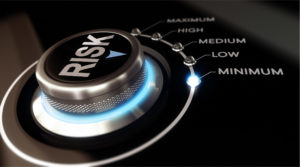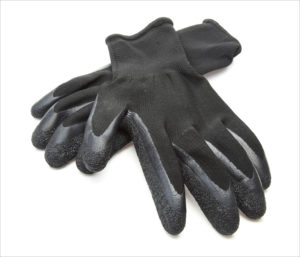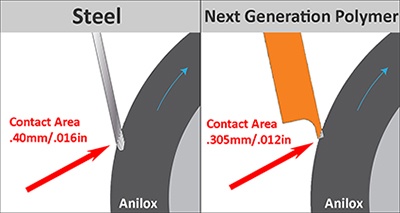 Workplace hazards are present in almost every industry, and the printing industry is no exception. A press operator faces many dangers at work every day. One of the greatest is the risk of serious lacerations to his hands if he’s using steel doctor blades. He is exposed to being cut anytime he’s handling them – installing or removing them from the press, cleaning them, disposing them and when changing end seals. The blades are especially dangerous when being replaced – their edges become honed through contact with the anilox roll as they wear, leaving razor-sharp tips that can cause serious cuts.
Workplace hazards are present in almost every industry, and the printing industry is no exception. A press operator faces many dangers at work every day. One of the greatest is the risk of serious lacerations to his hands if he’s using steel doctor blades. He is exposed to being cut anytime he’s handling them – installing or removing them from the press, cleaning them, disposing them and when changing end seals. The blades are especially dangerous when being replaced – their edges become honed through contact with the anilox roll as they wear, leaving razor-sharp tips that can cause serious cuts.
Fortunately, printers have a variety of options to reduce or eliminate the risk of injuries from steel doctor blades without sacrificing print quality.
Wear personal protective equipment
 When worn correctly, cut-resistant gloves can prevent injuries to operators when using steel blades. However, the U.S. Bureau of Labor Statistics 2012 figures show that about 70% of lost-time hand injuries occur on workers who aren’t wearing gloves. The remaining 30% are wearing gloves at the time of the accident, but the gloves are inadequate, damaged or the wrong type for the job. It goes to show, the steel doctor blade risk of serious lacerations to a press operator’s hands doesn’t just go away with wearing protective gloves.
When worn correctly, cut-resistant gloves can prevent injuries to operators when using steel blades. However, the U.S. Bureau of Labor Statistics 2012 figures show that about 70% of lost-time hand injuries occur on workers who aren’t wearing gloves. The remaining 30% are wearing gloves at the time of the accident, but the gloves are inadequate, damaged or the wrong type for the job. It goes to show, the steel doctor blade risk of serious lacerations to a press operator’s hands doesn’t just go away with wearing protective gloves.
Establish occupational health and safety programs
Companies with safety and health management programs reduce their injury and illness costs by an estimated 20-40% according to the Occupational Safety and Health Administration (OSHA). In fact, an ASSE white paper by OSHA’s Office of Regulatory Analysis suggests that companies that implement effective safety and health programs can expect a return of $4 to $6 for every $1 invested. These programs lead to improved productivity and employee well-being in addition to reducing injury-related direct and indirect costs. Training employees and documenting handling procedures can also be beneficial in reducing the doctor blade risk of lacerations. In the pressroom, operators should be taught how to minimize their exposure to the risks from steel doctor blades by following standard protocols – for example by keeping blades in their protective packaging until they are ready to be installed and not changing blades on a machine while it’s running.
Switch to plastic doctor blades
The above options will certainly lower the risk of getting cut by steel blades but switching to plastic doctor blades will completely eliminate this doctor blade risk. Plastic materials are inherently softer and less sharp than steel. Even when plastic blades are worn, their edges are not sharp enough to cut a press operator.
Unlike in the past, a printer producing high-quality graphics now has the option of choosing a plastic blade for its safety benefits. Next generation polymer blades with MicroTip® technology can compete with the metering performance of steel in even the most demanding graphics applications while retaining the safety benefits of traditional plastic.
Next generation polymers with MicroTip®
 Today’s advanced polymer material is stiffer than traditional plastic and can support a precisely engineered MicroTip edge. This tip design allows the blade to achieve and maintain a fine contact area with the anilox roll comparable to a steel blade. Next generation polymer blades are able to effectively meter line screens up to 2000 LPI or 785 L/cm and produce graphics of the highest quality. The MicroTip has a long and steady wear period which reduces the frequency of blade changes and delivers consistent ink film thickness for the duration of the print job.
Today’s advanced polymer material is stiffer than traditional plastic and can support a precisely engineered MicroTip edge. This tip design allows the blade to achieve and maintain a fine contact area with the anilox roll comparable to a steel blade. Next generation polymer blades are able to effectively meter line screens up to 2000 LPI or 785 L/cm and produce graphics of the highest quality. The MicroTip has a long and steady wear period which reduces the frequency of blade changes and delivers consistent ink film thickness for the duration of the print job.
Today’s printers have more options than ever to improve workplace safety. Protective gear and safety programs will no doubt reduce the risk of injuries from steel doctor blades. But if you want to completely eliminate these injuries, then completely eliminate steel blades from your pressroom. Switch to next generation polymer blades and get the best of both worlds – high performance metering and safety.
Look for part three of our In Safe Hands with Polymer Doctor Blades Blog Series – “Not the Sharpest Blade in the Pressroom.”
Part 1: “Numbers That Add Insults to Doctor Blade Injuries“ – Read about the frequency of hand injuries in the workplace and their impact on a company’s bottom line
